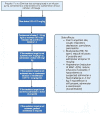Anesthesia for Endovascular Therapy for Stroke
- PMID: 38921954
- PMCID: PMC11206672
- DOI: 10.3390/neurolint16030050
Anesthesia for Endovascular Therapy for Stroke
Abstract
Background: In patients with acute ischemic stroke, the standard of care is to perform intra-arterial endovascular thrombectomy in addition to intravenous thrombolysis. In this study, we investigated the different anesthetic techniques chosen for this procedure and clinical outcomes.
Methods: Patients undergoing endovascular procedures were divided into three groups. The first group consisted of patients who received general anesthesia, the second group underwent the procedure under conscious sedation and local anesthesia at the catheter insertion site, and lastly the third group included patients who received only local anesthesia at the catheter insertion site, without sedation.
Results: During the endovascular procedure, we did not notice significant differences in vital parameters, in particular the mean blood pressure (MAP) between patients treated with different types of anesthesia. Also, the duration of the revascularization did not show significant differences between the three groups. The main point is the absence of differences in terms of functional and clinical outcomes, using various scores as reference, such as the National Institutes of Health Stroke Scale (NIHSS) score at 7 days, NIHSS and Modified Rankin Scale (MRS) at time of discharge, and MRS after 3 months. These scores did not show significant differences in groups treated with different types of anesthesia.
Conclusions: The rate of success of the revascularization procedure is almost overlapping between patients treated with conscious sedation and general anesthesia. In addition, we did not notice significant differences between groups in terms of functional and clinical outcomes. Considering the possible usefulness of applying conscious sedation, at OCSAE of Baggiovara, an internal protocol for conscious sedation was introduced to standardize the treatment in patients undergoing endovascular procedures.
Keywords: conscious sedation; endovascular therapy; stroke.
Conflict of interest statement
The authors declare no conflict of interest.
Figures
Similar articles
-
Effect of Conscious Sedation vs General Anesthesia on Early Neurological Improvement Among Patients With Ischemic Stroke Undergoing Endovascular Thrombectomy: A Randomized Clinical Trial.JAMA. 2016 Nov 15;316(19):1986-1996. doi: 10.1001/jama.2016.16623. JAMA. 2016. PMID: 27785516 Clinical Trial.
-
Anesthetic strategy during endovascular therapy: General anesthesia or conscious sedation? (GOLIATH - General or Local Anesthesia in Intra Arterial Therapy) A single-center randomized trial.Int J Stroke. 2016 Dec;11(9):1045-1052. doi: 10.1177/1747493016660103. Epub 2016 Jul 12. Int J Stroke. 2016. PMID: 27405859 Clinical Trial.
-
Conscious sedation compared to general anesthesia for intracranial mechanical thrombectomy: A meta-analysis.Brain Behav. 2021 Jun;11(6):e02161. doi: 10.1002/brb3.2161. Epub 2021 May 7. Brain Behav. 2021. PMID: 33960706 Free PMC article. Review.
-
General Anesthesia Versus Conscious Sedation for Endovascular Treatment of Acute Ischemic Stroke: The AnStroke Trial (Anesthesia During Stroke).Stroke. 2017 Jun;48(6):1601-1607. doi: 10.1161/STROKEAHA.117.016554. Stroke. 2017. PMID: 28522637 Clinical Trial.
-
Association of General Anesthesia vs Procedural Sedation With Functional Outcome Among Patients With Acute Ischemic Stroke Undergoing Thrombectomy: A Systematic Review and Meta-analysis.JAMA. 2019 Oct 1;322(13):1283-1293. doi: 10.1001/jama.2019.11455. JAMA. 2019. PMID: 31573636 Free PMC article.
Cited by
-
Endovascular Treatment of Stroke and Anesthesia Technique: What Is the Best Approach, According to the Literature?Neurol Int. 2025 Jul 25;17(8):115. doi: 10.3390/neurolint17080115. Neurol Int. 2025. PMID: 40863984 Free PMC article. Review.
References
-
- Turc G., Bhogal P., Fischer U., Khatri P., Lobotesis K., Mazighi M., Schellinger P.D., Toni D., de Vries J., White P., et al. European Stroke Organisation (ESO)-European Society for Minimally Invasive Neurological Therapy (ESMINT) guidelines on mechanical thrombectomy in acute ischemic stroke. J. Neurointerv. Surg. 2019;11:535–538. doi: 10.1136/neurintsurg-2018-014568. - DOI - PubMed
-
- Wahlgren N., Moreira T., Michel P., Steiner T., Jansen O., Cognard C., Mattle H.P., van Zwam W., Holmin S., Tatlisumak T., et al. Mechanical thrombectomy in acute ischemic stroke: Consensus statement by ESO-Karolinska Stroke Update 2014/2015, supported by ESO, ESMINT, ESNR and EAN. Int. J. Stroke. 2016;11:134–147. doi: 10.1177/1747493015609778. - DOI - PubMed
LinkOut - more resources
Full Text Sources


